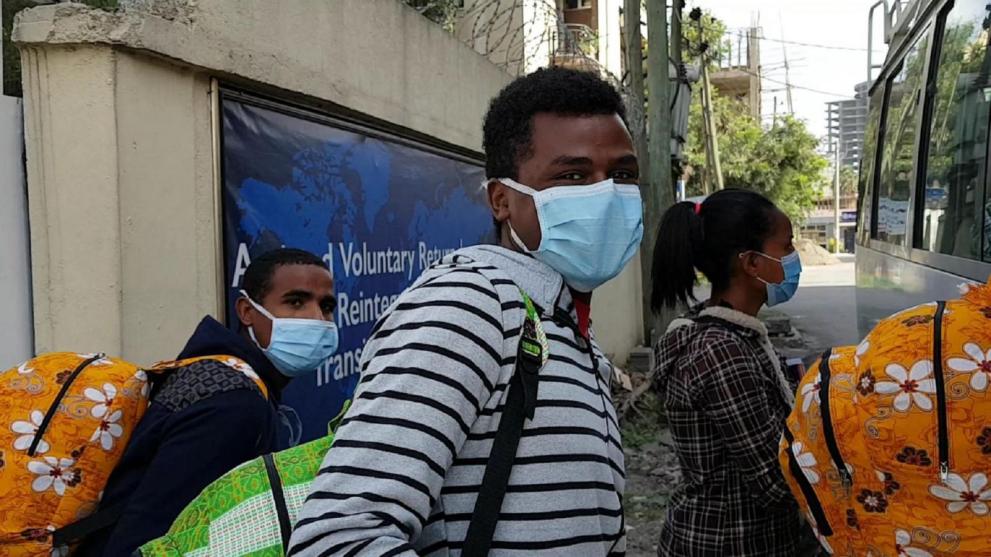
Story by Helina Mengistu and Wilson Johwa
“I am back, alive and healthy. I can make a fresh start in my country. I am hopeful for the future”, Teketel, a 18 year old Ethiopian says after surviving a container trip that killed 64 out of 74 people that were being smuggled to South Africa through Mozambique.
Lean with short curly hair and prone to an easy smile, Teketel looks like a regular teenager, except that he survived ordeals many others cannot even imagine.
“The container was too hot, like fire,” he recalls. “There was no oxygen, and people around me started to die one by one”.
It was a tragedy that shook the African continent: the remains of 64 migrants from Ethiopia were found locked in a container at the back of a truck, on 24 March near Tete, Mozambique, after crossing over the Malawi-Mozambique border.
“We did not want to go into that container. It could barely fit 10 people. But they (the smugglers) threatened us with a machete and left us no choice”, he explains. We were stopped after an eight-hour drive and after people had screamed and banged on the container, hoping to be saved. By the time the security patrol stopped the truck and opened the door, only 14 were still breathing.
The survivors — except for three who probably continued with the journey — decided to return home. This was made possible thanks to the joint efforts of the governments of Ethiopia and Mozambique assisted by the EU-IOM Joint Initiative for Migrant Protection and Reintegration in the Horn of Africa.
The road to South Africa: On foot, by motorbike and in containers
Teketel did not pass his tenth-grade exams and with no prospects of getting a job in his small town of Lisana, he decided to join an old friend who migrated to South Africa. “Soon after the discussion with my friend, the smugglers called to tell me to prepare for the road. They instructed me to go to Moyale,” he says.
Moyale, 650km away from his home, sits on the Ethiopia-Kenya border. It is the first border Ethiopian migrants cross at the onset of their journey to South Africa. The overland route from the Horn of Africa to South Africa — also known as the Southern Route — remains largely understudied with little current and comprehensive data available, despite being one of the most dangerous and challenging migration routes on the continent.
Teketel did not know who the smugglers were — his friend made all the arrangements and payments from South Africa. “After Moyale, I walked through a Kenyan forest for days; thorn bushes ripped up by clothes. The smugglers left us in the forest to spend nights and gave each of us one piece of bread every 24 hours,” says Teketel.
“We reached Nairobi and continued the journey all the way to Malawi mostly on foot, but sometimes by motorbike and in containers. Some containers were ventilated; some weren’t, like the one that took us to Mozambique”, he explains.
After the discovery by Mozambican authorities, officials of the Mozambican National Migration Service (SENAMI) brought the survivors to a hospital in Tete, where the young men were treated for dehydration and exhaustion. They spent a required quarantine period as part of Mozambique’s COVID-19 prevention measures. IOM Mozambique contacted the Ethiopian Consulate in Pretoria, South Africa. IOM provided translation services between the Consulate, the migrants and the local authorities, and worked to facilitate their voluntary return to Ethiopia.
Returning home
On 28 April, the 11 men travelled to Mozambique’s capital, Maputo. There, IOM provided clothes, personal hygiene items as well as items to reduce risks of exposure to COVID-19. The following day, the survivors boarded a plane for Ethiopia.
“I was having nightmares and unable to sleep soon after my return,” says Teketel. Upon their return, IOM provided the migrants with psychosocial counseling. Local transportation to their home communities was facilitated after the completion of the mandatory 14-day quarantine due to COVID 19.
They were also consulted about their individual reintegration plans. Some planned to engage in cattle fattening and the grain trade while others were preparing to open retail shops.
Teketel is excited to open a gaming house with several pool tables in his town that has limited recreational options for youth like himself.
“My friend later told me that he paid 4,600USD to smugglers, the money is lost, but money can be regained”, he says.
About the EU-IOM Joint Initiative
Funded by the European Union (EU) Emergency Trust Fund for Africa, the EU-IOM Joint Initiative for Migrant Protection and Reintegration is the first comprehensive programme bringing together 26 African countries of the Sahel and Lake Chad region, the Horn of Africa, and North Africa, the EU and IOM around the shared goal of ensuring that migration is safer, more informed and better governed for both migrants and their communities.
Details
- Publication date
- 27 July 2020
- Region and Country
- Horn of Africa
- Thematic
- Improved migration management
- Partner
- International Organization for Migration
